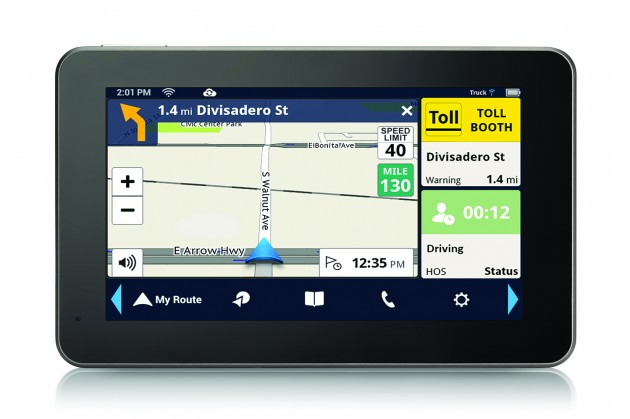Reviewing Magellan’s newest RoadMate GPS unit
No doubt there is a niche for a superior truck GPS in this world; Garmin and Rand McNally are strong contenders in this field. But a new product by Magellan wants to steal the crown.
Magellan’s RoadMate Commercial RC9485T-LMB was introduced in January 2015, and sports a surfeit of features: fuel prices, weather, traffic, trip routing, log books, HoS and IFTA recording. According to the manufacturer, “(This) is a dedicated 7” Android tablet with truck navigation and mount. It is designed specifically for a trucker with everything built in.” 
That’s all well and good. But when it comes to truck GPS, I’m basically only interested in four things: traffic, good routing, user-friendliness, and infallibility.
I might add toughness to this list. A truck GPS should be able to survive the rigors of slip-seating. As a run-coverage driver I’m often switching trucks and throwing the GPS in my bag at the end of the day. My old Garmin Dezl 560 scores well in this regard, although the traffic function has stopped working long ago.
And the machine shouldn’t come crashing off the windshield when the defrost or the A/C changes the temperature of the glass. The Magellan RoadMate has superb suction and a reinforced adjustable bracket that gave me no woes.
The RoadMate retails on the expensive side ($400 on sale at Canadian Tire) but with free lifetime updates and good traffic schematics, it’s probably worth it. For me, the more traffic data you can access, the better. This unit saved me some time around the Hwy. 7 and Jane intersection on a busy Friday afternoon. I wanted to get on the 400 southbound but the Magellan showed a major delay at Jane, so a quick re-route up Creditstone to Langstaff and then over to the 400 easily saved me 20 minutes of bumper to bumper.
I’ve owned half a dozen GPS units and I can tell you that I’m only really comfortable when I’ve got a map book in my backpack, just in case. I can cite lots of times where GPS has let a driver down, and I don’t want to be that driver. But I left the map book at home for this test ride and decided to trust the RoadMate.
Although my initial learning curve was steep, once I got the hang of the search function and figured out how the split screen worked, it was completely functional. I prefer to see where I’m going rather than being told, and the RoadMate provides a good overview and as much guidance as you want.
I found flipping between the turn list (constantly updated as you roll) and the 3D road view kept me focused on my destination and only minimally distracted. And the ETAs offered by the machine were surprisingly accurate.
I haven’t figured out the multiple routing sequence; it’s a complicated device for me, but I plugged in my calls one at a time and that worked fine. The machine saves previous addresses, but insists on exact spelling in the initial search.
I’m still filling out paper logs, but I suppose the e-logs version offered on the RoadMate is as good as what other drivers are running on their company smartphones. Logbooks can still be mechanically printed by means of an SD card, which can be removed from the device without disconnecting it from the truck.
The weather and fuel prices options are even less important to me. Pairing with WiFi or a bluetooth-enabled phone allows you to get weather and the price of gas in certain North American cities. I’m a weather-watcher but get my weather from other sources. The inspection station icon pops up about a mile before the chicken coop but I’d prefer a little more warning. Settings allow you to switch between miles and kilometres and it’s nice to switch into car mode on occasion; truck routes are not always the most efficient or necessary.
So what did we do before GPS? It’s like asking what did we do before the Internet. We still got to where we were going. You weren’t much of a truck driver if you couldn’t read a map.
Trucking pioneers like Ross Mackie were running roads in western Canada before they were literally built (the Trans-Canada wasn’t completed until the mid-60s), and he can still find his way anywhere in North America without a map or GPS.
My point is that for an old-timer like me, GPS is still the new kid on the block, and has to prove itself. In that regard, the RoadMate was more than capable. I couldn’t find any problems with the routing or the data. The machine has levels and degrees of complexity I haven’t yet discovered, but it gets a 53-foot trailer from point A to B efficiently, and that’s what really matters.
Have your say
This is a moderated forum. Comments will no longer be published unless they are accompanied by a first and last name and a verifiable email address. (Today's Trucking will not publish or share the email address.) Profane language and content deemed to be libelous, racist, or threatening in nature will not be published under any circumstances.
I HAVE REPLACED 2 OF THIS UNIT IN LESS THAN 3 MONTHS. UNIT LOCKS UP AT UPDATE AND WILL NOT COME OUT OF UPDATE MODE. NOT SURE WHAT AM DOING WRONG BUT AFTER SPENDING $400 FOR THE UNIT, I DO EXPECT A SIMPLER AND EFFICIENT UPDATING SYSTEM. I AM NOT IMPRESSED WITH THE PRODUCT